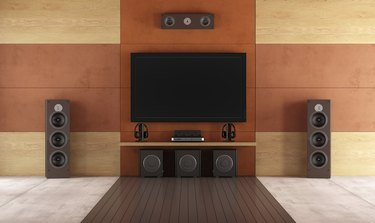
The jobs of receivers and amplifiers overlap, as receivers are essentially tuners with amplifiers built-in. An audio-visual receiver can function as an audio distribution system, and as such, it functions as a jack-of-all-trades. A good-quality vintage stereo amp does one thing, and it performs better than the receiver when providing music and left and right front-channel audio. Adding an older power amplifier depends on your AV amplifier having audio pre-amp outputs for at least the left and right front channels. This is available on many but not all AV amplifiers.
Step 1
Locate the pre-amp outputs on the back of the AV receiver. These will be white and red RCA-style jacks. A common labeling convention for these connectors is "pre out." Surround channels use other colors, but front-channel left and right jacks are always colored white and red, respectively.
Video of the Day
Step 2
Connect the RCA stereo audio cable to the AV receiver, color-matching the plugs of the cable with the pre-out jacks on the receiver. Connect the other end of the audio cable to a line-level input on your power amp. Usually a pair of jacks labeled "aux" or "auxiliary" are used, but any inputs are suitable, with the exception of "phono" inputs. These are dedicated to turntables that have special pre-amp and equalization needs.
Step 3
Connect speakers to the power amp and turn on all components in your home theater system. When viewing content with surround sound content, balance the output of the main content using the amplifier, and with the surround content using the AV receiver. Stereo content, such as a CD or non-surround broadcast, is controlled exclusively by the power amp, though the AV receiver must be on to pass through the audio signal.
Video of the Day